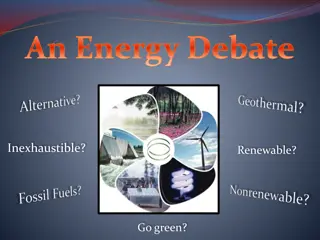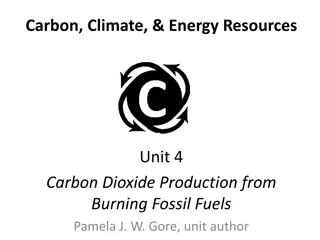Understanding Nonrenewable Energy Resources and Fossil Fuels
Natural resources like minerals are essential for various purposes, but most minerals are nonrenewable resources. This means they cannot be replaced within a short timeframe. Fossil fuels, such as coal, oil, and natural gas, are ancient forms of energy derived from buried plant and animal remains, making them nonrenewable due to the extensive time needed for their formation.
Uploaded on Sep 16, 2024 | 0 Views
Download Presentation

Please find below an Image/Link to download the presentation.
The content on the website is provided AS IS for your information and personal use only. It may not be sold, licensed, or shared on other websites without obtaining consent from the author. Download presentation by click this link. If you encounter any issues during the download, it is possible that the publisher has removed the file from their server.
E N D
Presentation Transcript
Any natural substance used by living things can be considered a natural resource. For example, minerals, such as copper and iron, are natural resources. Most metals are examples of minerals.
Most minerals are nonrenewable resources. What does that mean?
Nonrenewable Energy Resources
Nonrenewable Resources Either can never be replaced or can only be replaced over very long periods of time Limited resource Fossil Fuels (remains of living things)
Millions of years ago, plants began converting energy from the Sun into their own energy. Other organisms ate some of those plants. When those plants and animals became buried under rock, they eventually became oil and coal. Thus, the energy from oil and coal started as energy from the Sun. Nonrenewable Energy Resources [1:22]
Fuels that come from ancient plants and animals are known as fossil fuels. Fossil fuels contain a lot of carbon. Because fossil fuels contain a lot of carbon, along with hydrogen and oxygen, they burn easily. The three major fossil fuels are oil, coal, and natural gas. Because of the millions of years it takes for fossil fuels to form, they are considered nonrenewable. Fossil Fuels with Bill Nye [5:44] Formation of Fossil Fuels [2:25]
Which of the following energy resources do YOU think are NONRENEWABLE?
Coal A rock that contains at least 50% plant remains. Forms when plants die in a swampy area and are covered.
Oil Thick, black liquid formed from buried remains of microscopic marine organisms. Used for gasoline and plastics
Natural Gas Forms in a gaseous state- is a hydrocarbon that is lighter than oil. Used for heating and cooking
Nuclear Energy Energy produced by atomic reactions. Nuclear fission heavy elements are split and energy is produced. Produces waste
Propane a flammable hydrocarbon gas present in natural gas and used as bottled fuel.
What is the ultimate source of energy in fossil fuels? The sun Plants and algae lock this energy into organic matter When we burn plants or fossil fuels, we release the sun s trapped energy
The Earths resources can be reduced or used up if humans don t use conservation strategies People can slow down the degradation (ruin) of the environment and the depletion of nonrenewable resources.
Renewable Energy Resources
Renewable Resources can be replaced in the space of a human lifetime
Which of the following energy resources do YOU think are RENEWABLE?
Solar Energy Energy from the Sun Solar cells collect energy from the Sun and transform it into electricity.
Solar Energy Scientists are working to develop ways to capture more of this energy For example, buildings in colder areas can be designed to trap more solar energy. A building in a colder area would retain more heat from the Sun, less energy would be needed to cool it. The opposite is also true. Why would a building in a colder area retain more heat from the Sun?
Wind Energy Windmills or wind turbines (mechanical windmills) are used to generate electricity Wind farms are areas where many wind turbines are set up to generate electricity
Wind Energy Wind farms are often build on coastland, where there is an abundance of wind, and on farmland Why is there an abundance of wind on the coastland?
Wind Energy The advantage of wind turbines is that they use a renewable resource to produce electricity What are the disadvantages? Birds and bats can die after flying into a turbine s blades Wind turbines are loud, contributing to noise pollution
Hydroelectric Running water is used to generate electricity The energy of moving water turns turbines that are connected to generators. The generators convert the mechanical energy into electrical energy
Hydroelectric Dams are built on large rivers to slow the flow of water and create lakes. The water moves through the dam generating electricity, and is allowed to flow out at the bottom of the dam The advantage of hydroelectric power is that it is renewable
Hydroelectric What are the disadvantages of hydroelectric energy? Lakes were created in places where people lived, so they had to move Sometimes fish use places further up the river as places to reproduce and they either died out or the dams had to have special structures built to allow the fish to go upstream past the dam
Geothermal Energy that is extracted (removed) from the ground In areas of the world where the heat from Earth is closer to the surface, machinery is built that helps pull up heat from below the surface. The heat is brought up to a turbine where the heat helps spin a turbine which spins a generator and electricity is created
Biomass Fuel produced from biological energy sources such as plant materials, manure, sawdust, paper waste, and other organic materials.
Biomass For example, corn can be converted into ethanol, a type of alcohol that can be used as fuel Biodiesel is made from old frying oil and is used in vehicles that burn diesel, a fuel that is usually made from fossil fuels
oBill Nye Renewable Energy [3:07] oRenewable Energy Resources: Part 1 [1:47] oRenewable Energy Resources: Part 2 [1:17]
Conservation- To preserve and protect resources























